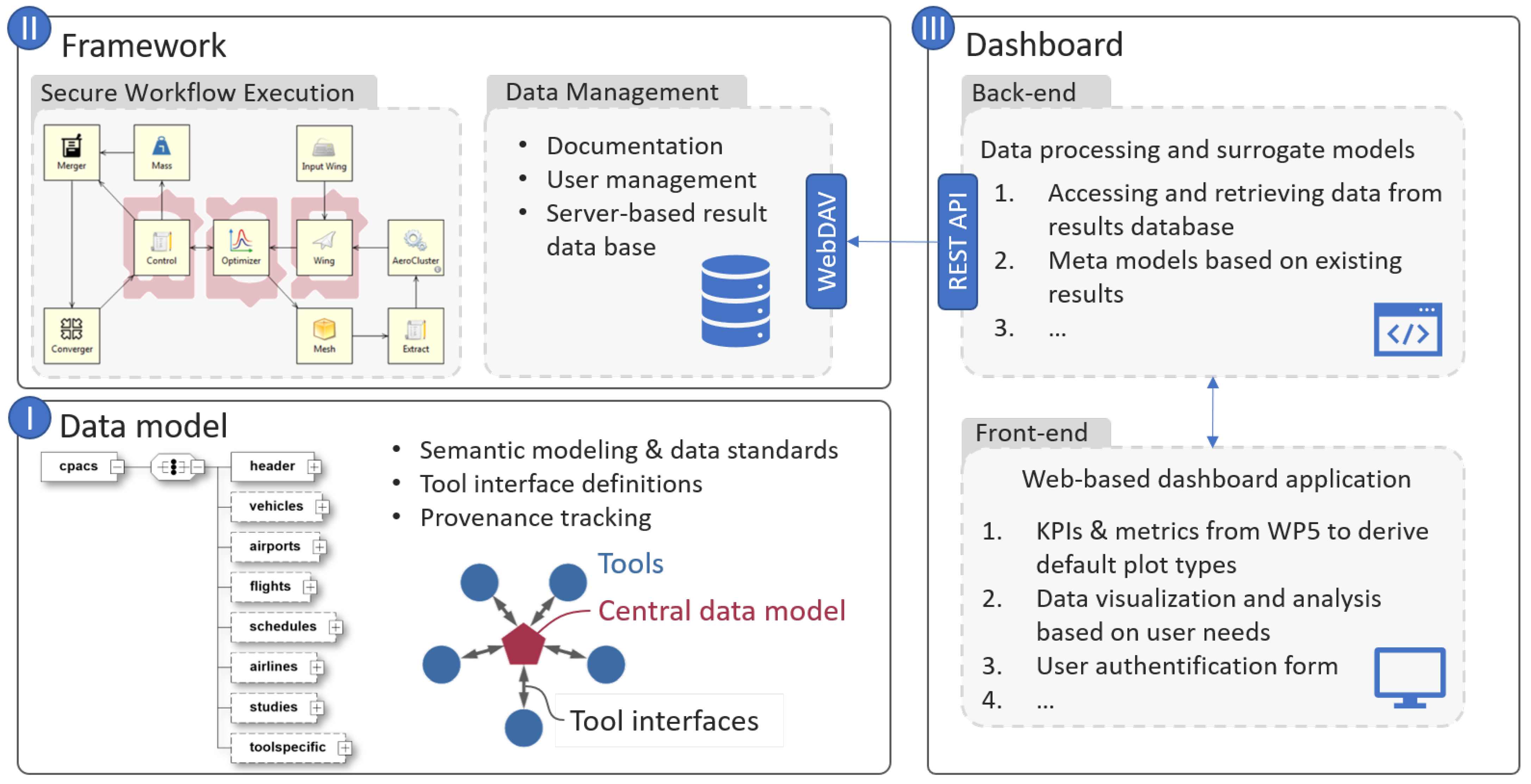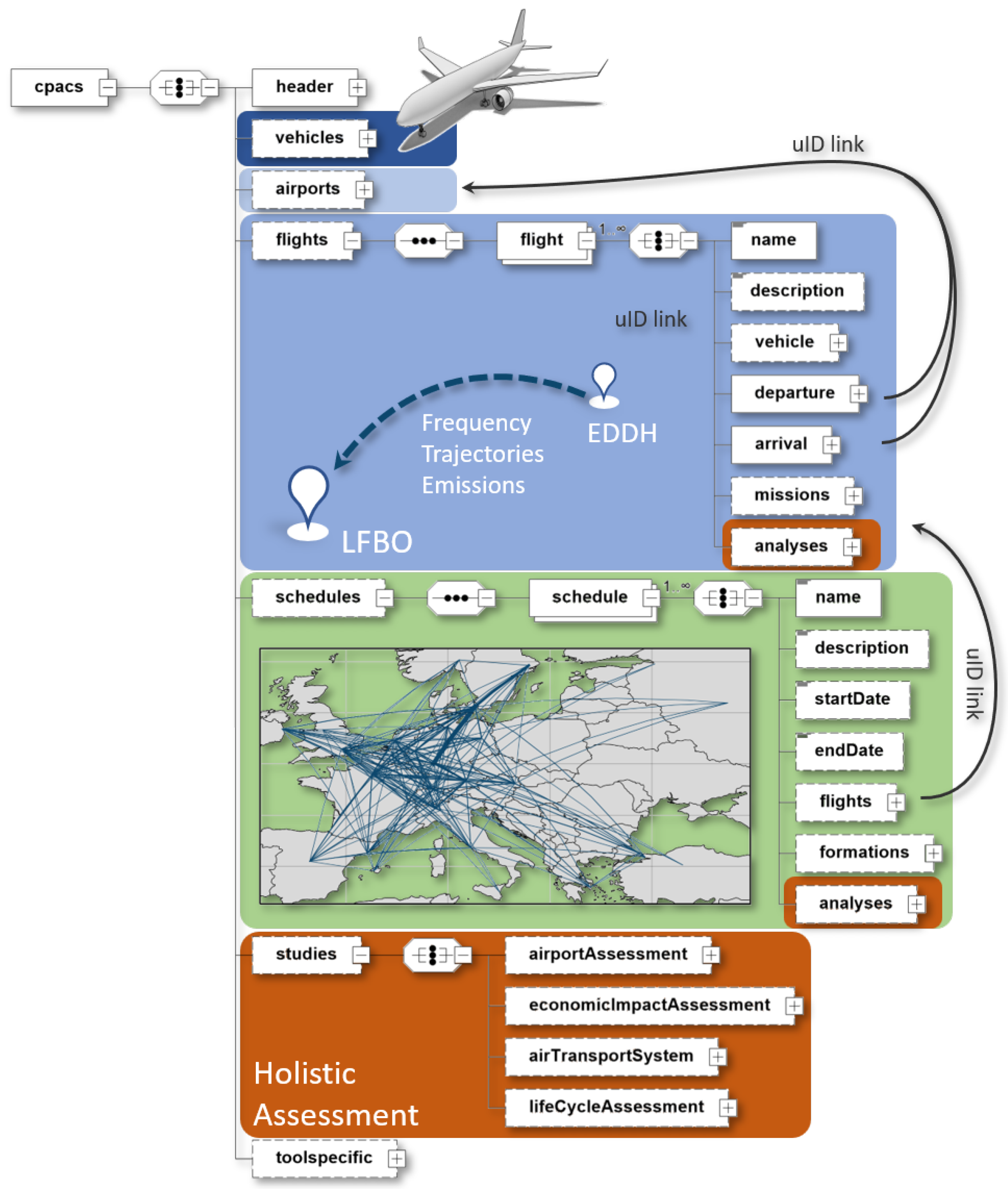Impact Monitor Framework: Development and Implementation of a Collaborative Framework for Aviation Impact Assessment †
Abstract
:1. Introduction
2. Requirements
3. State of the Art Review and Technology Selection
3.1. Data Modeling
3.2. Framework
3.3. Dashboard
4. Implementation
4.1. Data Model: Using MDAx to Extend CPACS Towards ATS
4.2. Framework: Uplink and Brics for Secure Remote Execution of Workflows
4.3. Framework: Development of a RCE-to-NextCloud Interface
4.4. Dashboard Application
5. Application Cases and Lessons Learned
6. Conclusions and Next Steps
Author Contributions
Funding
Institutional Review Board Statement
Informed Consent Statement
Data Availability Statement
Acknowledgments
Conflicts of Interest
References
- Terrenoire, E.; Hauglustaine, D.A.; Gasser, T.; Penanhoat, O. The contribution of carbon dioxide emissions from the aviation sector to future climate change. Environ. Res. Lett. 2019, 14, 084019. [Google Scholar] [CrossRef]
- Hirst, M. The Air Transport System; Woodhead Publishing Limited: Cambridge, UK, 2008. [Google Scholar] [CrossRef]
- Kaiser, J.; Vernaleken, C. Civil Aviation. In Information Ergonomics; Springer: Berlin/Heidelberg, Germany, 2012; pp. 135–158. [Google Scholar] [CrossRef]
- Brennan, K. (Ed.) A Guide to the Business Analysis Body of Knowledge(R) (BABOK(R) Guide); International Institute of Business Analysis: Toronto, ON, Canada, 2009. [Google Scholar]
- Zamfir, A.; Jepsen, J.; Moerland, E.; Nagel, B. Development of a Modular Knowledge-Based Model Generator for the Preliminary Aircraft Design Process of the Future. In Proceedings of the 2018 Aviation Technology, Integration, and Operations Conference, Atlanta, GA, USA, 25–29 June 2018. [Google Scholar] [CrossRef]
- The lxml.etree Tutorial. Available online: https://lxml.de/tutorial.html (accessed on 17 November 2024).
- Tixi: Fast and Simple xml Interface Library. Available online: http://dlr-sc.github.io/tixi (accessed on 15 September 2024).
- Siggel, M.; Kleinert, J.; Stollenwerk, T.; Maierl, R. TiGL: An Open Source Computational Geometry Library for Parametric Aircraft Design. Math. Comput. Sci. 2019, 13, 367–389. [Google Scholar] [CrossRef]
- Lafage, R.; Defoort, S.; Lefebvre, T. WhatsOpt: A web application for multidisciplinary design analysis and optimization. In Proceedings of the AIAA Aviation 2019 Forum, Dallas, TX, USA, 17–21 June 2019. [Google Scholar] [CrossRef]
- Gallard, F.; Vanaret, C.; Guénot, D.; Gachelin, V.; Lafage, R.; Pauwels, B.; Barjhoux, P.J.; Gazaix, A. GEMS: A Python Library for Automation of Multidisciplinary Design Optimization Process Generation. In Proceedings of the 2018 AIAA/ASCE/AHS/ASC Structures, Structural Dynamics, and Materials Conference, Kissimmee, FL, USA, 8–12 January 2018. [Google Scholar]
- Garg, S.; Bussemaker, J.; Boggero, L.; Nagel, B. MDAX: Enhancements in a Collaborative Mdao Workflow Formulation Tool. In Proceedings of the ICAS Conference 2024, Florence, Italy, 9–13 September 2024. [Google Scholar]
- WITNESS4Climate. Available online: https://www.witness4climate.org/ (accessed on 17 November 2024).
- Forkert, T.; Kersken, H.P.; Schreiber, A.; Strietzel, M.; Wolf, K. The Distributed Engineering Framework TENT. In Vector and Parallel Processing—VECPAR 2000; Springer: Berlin/Heidelberg, Germany, 2001; pp. 38–46. [Google Scholar] [CrossRef]
- Ansys ModelCenter: Connecting System Requirements to Engineering Analysis. Available online: https://www.ansys.com/products/connect/ansys-modelcenter (accessed on 17 November 2024).
- Boden, B.; Flink, J.; Först, N.; Mischke, R.; Schaffert, K.; Weinert, A.; Wohlan, A.; Schreiber, A. RCE: An Integration Environment for Engineering and Science. SoftwareX 2021, 15, 100759. [Google Scholar] [CrossRef]
- Habala, O.; Bobák, M.; Šeleng, M.; Tran, V.; Hluchý, L. Architecture of a Function-as-a-Service Application. Comput. Inform. 2023, 42, 878–895. [Google Scholar] [CrossRef]
- Hluchý, L.; Habala, O.; Bobák, M.; Šeleng, M. Transformation of a Legacy Airport Meteorology Application into a Serverless Cloud Application. In Proceedings of the 2023 IEEE 17th International Symposium on Applied Computational Intelligence and Informatics (SACI), Timisoara, Romania, 23–26 May 2023; pp. 000637–000642. [Google Scholar] [CrossRef]
- Flask Documentation. Available online: https://flask.palletsprojects.com (accessed on 14 September 2024).
- Angular. Available online: https://angular.dev (accessed on 5 December 2024).
- Vue.js: The Progressive JavaScript Framework. Available online: https://vuejs.org/ (accessed on 5 December 2024).
- React: The Library for Web and Native User Interfaces. Available online: https://react.dev (accessed on 5 December 2024).
- Baalbergen, E.; Moerland, E.; Lammen, W.; Ciampa, P.D. Methods Supporting the Efficient Collaborative Design of Future Aircraft. In Proceedings of the Aerospace Europe 6th CEAS Conference, Bucharest, Romania, 16–20 October 2017. [Google Scholar]
- Gupta, U.; Riaz, A.; Brenner, F.; Lefebvre, T.; Ratei, P.; Alder, M.; Prakasha, P.S.; Weber, L.; Pons-Prats, J.; Markatos, D. Assessing Advanced Propulsion Systems using the Impact Monitor framework. In Proceedings of the 14th EASN International Conference, Thessaloniki, Greece, 8–11 October 2024. [Google Scholar]
- Pons-Prats, J.; Prats, X.; de la Torre, D.; Sole, E.; Hoogers, P.; van Eenige, M.; Chatterjee, S.; Prakasha, P.S.; Ratei, P.; Alder, M.; et al. Assessing continuous descent operations using the Impact Monitor Framework. In Proceedings of the 14th EASN International Conference, Thessaloniki, Greece, 8–11 October 2024. [Google Scholar]
- Mayeres, I.; Peduzzi, E.; Alder, M.; Baier, F.; Buchtal, K.; Chatterjee, S.; Clococeanu, M.; Ennen, D.; Gelhausen, M.; Junior, A.; et al. Assessing policies for the uptake of sustainable aviation fuels using the Impact Monitor framework. In Proceedings of the 14th EASN International Conference, Thessaloniki, Greece, 8–11 October 2024. [Google Scholar]



| Prio. | Requirement |
|---|---|
| (a) Data model requirements | |
| M | Data must be accessible via a suitable API. |
| M | Workflows must be easy to generate. |
| M | FAIR principle must be followed. |
| M | The execution network must meet security issues. |
| M | Secure user data handling is required. |
| (b) Framework requirements | |
| M | The user shall be able to access the dashboard app through a web browser. |
| M | User access should be through secure login credentials to ensure data privacy and security. |
| M | The system shall be able to import use case results data represented in tabular form. |
| M | The system shall be able to create various types of interconnected plots for loaded data. |
| M | The system should enable the users to interactively filter data locally and globally. |
| (c) Dashboard requirements | |
| M | The user shall be able to access the dashboard app through a web browser. |
| M | User access should be through secure login credentials to ensure data privacy and security. |
| M | The system shall be able to import use case results data represented in tabular form. |
| M | The system shall be able to create various types of interconnected plots for loaded data. |
| M | The system should enable the users to interactively filter data locally and globally. |
Disclaimer/Publisher’s Note: The statements, opinions and data contained in all publications are solely those of the individual author(s) and contributor(s) and not of MDPI and/or the editor(s). MDPI and/or the editor(s) disclaim responsibility for any injury to people or property resulting from any ideas, methods, instructions or products referred to in the content. |
© 2025 by the authors. Licensee MDPI, Basel, Switzerland. This article is an open access article distributed under the terms and conditions of the Creative Commons Attribution (CC BY) license (https://creativecommons.org/licenses/by/4.0/).
Share and Cite
Alder, M.; Ratei, P.; Riaz, A.; Gupta, U.; Lefebvre, T.; Prakasha, P.S. Impact Monitor Framework: Development and Implementation of a Collaborative Framework for Aviation Impact Assessment. Eng. Proc. 2025, 90, 61. https://doi.org/10.3390/engproc2025090061
Alder M, Ratei P, Riaz A, Gupta U, Lefebvre T, Prakasha PS. Impact Monitor Framework: Development and Implementation of a Collaborative Framework for Aviation Impact Assessment. Engineering Proceedings. 2025; 90(1):61. https://doi.org/10.3390/engproc2025090061
Chicago/Turabian StyleAlder, Marko, Patrick Ratei, Atif Riaz, Utkarsh Gupta, Thierry Lefebvre, and Prajwal Shiva Prakasha. 2025. "Impact Monitor Framework: Development and Implementation of a Collaborative Framework for Aviation Impact Assessment" Engineering Proceedings 90, no. 1: 61. https://doi.org/10.3390/engproc2025090061
APA StyleAlder, M., Ratei, P., Riaz, A., Gupta, U., Lefebvre, T., & Prakasha, P. S. (2025). Impact Monitor Framework: Development and Implementation of a Collaborative Framework for Aviation Impact Assessment. Engineering Proceedings, 90(1), 61. https://doi.org/10.3390/engproc2025090061






